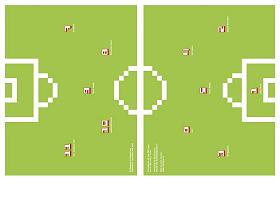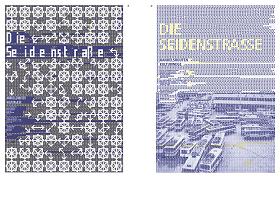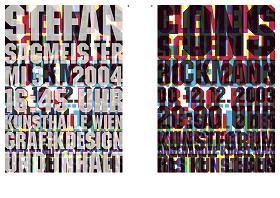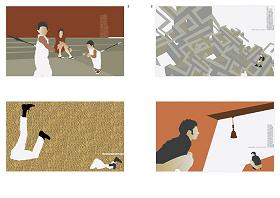|
Master




Students




|
Interview with Prof. Fons Hickmann
1. You are a professor of graphic design, yet to me you are primarily a successful designer. Do you think these are two completely different careers? Which one means more to you? How do you compromise the teaching of graphic design and your own practice of it?
I’m a modern nomad – both in the real and virtual worlds. The distance
between my Berlin studio and the university in Vienna is around 700
kilometres, so I spend a lot of time travelling. My life is shaped by
contrasts – Vienna and Berlin, day and night, studio and university,
virtual and real, black and white, I’m Dr. Jeckyl and Mr. Hyde.
2. During your educational communication with the students, has your work ever been influenced by the younger minds of design? If yes, in which respect is this so? How do you look at such an influence?
What exactly are “younger minds”? The “youngest” and mentally most
agile person in our class is Kari Bauer. Kari Bauer is our screen
printer. He was one of the first Actionists in Vienna. He has lived
through and survived every imaginable movement in art and design. He’s
now 66, but in terms of ideas and behaviour, the man is most definitely
a “young mind”.
3. As an internationally renowned graphic designer, many of your works are regarded as classics. I’m curious about whether the strong individual style in your characteristic works has an influence on the artistic creations of your students. How do you take hold of this influence? If a student emerges with a style very similar to yours, how would you feel and what would you do?
According to the Greek philosopher Socrates (or was it Aristotle?),
“The one who speaks is the teacher,” which basically means that
everyone learns from everyone else – irrespective of conventional
teacher/pupil roles. I’m not interested in inflexible styles in art or
design. I prefer to see people constantly reinventing themselves. It’s
hard but it’s more fun and leads to genuine creativity. If students
want to copy my work, that’s their business. Most of the worst
plagiarism is done by professionals anyway.
4. With the rapid development of science and technology, it is inevitable that the application of new technologies enter the realm of design. How do you see the relationship between new-tech and the training of traditional basic skills in your teaching?
---
5. The idea of Globalization is very popular these days. Is graphic design gradually losing its native character and regional identity? May I know your attitude towards the concept of “nationality” in your design and teaching?
Globalization is less popular amongst ordinary Europeans than it is
with multinational corporations. I’m in favour of everything that
strengthens the sharing of intellectual, cultural and economic
resources between societies. But I utterly detest the idea of a few
people enriching themselves at the expense of the rest of the planet.
Globalization is only positive if it benefits the weak and the
disadvantaged, not just the powerful – globalization should be a kind
of counterbalance towards creating a fairer world. Where intellectual
and cultural values are concerned, there is a particularly acute need
to intensify the sharing process. If societies become too
self-referential, major misunderstandings and conflicts can arise
between different cultures and religions. This type of communication
breakdown stems from a lack of knowledge about other systems, resulting
in an inability to understand or tolerate them. Intolerance, arrogance
and ignorance are the greatest dangers threatening our future.
6. Speaking of Globalization, I always feel that people today are emphasizing speed more than creativity of design.
How do you understand “speed”?
---
7. Savignac used to say posters are children on the streets. In Europe, people tend to understand the poster as an art on the street. Then, what do you think of posters being exhibited and kept in museums? How much time and effort will you devote to poster design in your class schedule?
Many people have declared the poster to be dead, but it simply refuses
to disappear. It keeps coming back. The same applies to the book and
the magazine. They’re all reincarnations. In design and art, everything
is a remake. Even the remakes get turned into remakes. That’s what
makes our work so important for the present moment, although ultimately
it’s meaningless.
8. Do you have any specific requirement for design theories in class? What are the books that you usually recommend to your students?
Dear students, please read more theories: Flusser, Virilio, Bartes,
Eco, Camus, Plato, McLuhan, Nietzsche, Kant. And inbetween all the
reading, don’t forget to eat, drink and have sex. You don’t have to
read everything, but theory adds critical depth to the design process.
The same applies to design itself. There are certain books, exhibitions
and other projects by important designers and artists that you simply
have to be familiar with.
9. How would you feel about the achievements and success of your students?
---
10. One last question, how do you define a "good designer" and a "good student" respectively? Thank you!
It must be love!
Jianping He / April 2004
|









